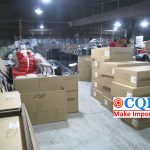Analyze The Industry Chain And Supply Chain From The Labor
The industrial revolution upgraded the manual manufacturing mode to the large-scale production realized by using tools, and manufacturing became the main driving force of economic growth. Manufacturing industry is divided into several stages from the division of labor dimension in the process of rapid development.
(1) No division of labor, where the same product is manufactured by one person.
(2) Division of labor among different processes within an enterprise, where the same product has multiple processes and each worker completes only one of them.
(3) Product standardization, where the manufacture of components is separated from the factory and the work is divided across enterprises (or parts are divided).
(4) Process standardization, process capability to achieve networked services, and division of labor according to capability (which can be a certain production capacity, or a certain design capability).
Take the pin manufacturing industry as an example: an untrained artisan who is not familiar with the machines of the industry cannot make a single pin in a day. By dividing the pin manufacturing into 18 processes, each done by 18 specific workers, these 18 people can make 48,000 pins a day.
Division Of Labor In The Industry Chain And Supply Chain
Division of labor within the factory
In contrast to the no division of labor at the beginning of the Industrial Revolution, the division of labor began after the pin-making process was divided into 18 processes. In the same factory, workers had different abilities due to different processes, which led to a division of labor within the factory. This most important watershed is the assembly line model, which is a major symbol of the division of labor among different processes within an enterprise.
In the early stage of the assembly line, most of the manufacturing processes were produced within the enterprise.
Cross-factory division of labor stage
With the development of the industry, products started to be abundant. After multiple products were produced by the same company, the complexity of management within the company increased dramatically. During this period, the process of product standardization was initiated, and after the standardization of components, companies could realize a new division of labor through the procurement of components.
For the automotive industry, the proportion of outsourced parts went from 30% in the 1950s to 70% of parts in the 1980s (the proportion is higher now). Thus, the division of labor of cross-enterprise components was achieved.

Enterprise capability division stage
The latest division of labor model is according to the ability to divide labor, this model first appeared in the chip manufacturing foundry, and chip design companies have chip design capabilities. The industry has re-implemented the division of labor according to whether the company has design capability and production capacity. A familiar example is the cooperation model between Apple and Foxconn, in which Apple designs products and Foxconn produces them. This model is potentially a new division of labor in manufacturing.
The CATENA-X alliance was established in Germany, which is a supply network, equipment manufacturing asset network, logistics network, finance network, demand network and related human resource network built around the value chain of the automotive industry, and these networks realize capacity supply with capacity services, thus realizing supply chain resilience and sustainable development.
The Distinction Between Industrial Chain And Supply Chain
According to the division of labor model introduced in the previous section, in the cross-plant division of labor stage, manufacturing companies are divided into suppliers and manufacturers. With the development of the industry, the requirement of instant collaboration between suppliers and manufacturers is getting higher and higher. After the maturity of IT technology and Internet technology, the upstream and downstream of enterprises realize cross-enterprise collaboration with the help of Internet tools.
The main characteristics of the supply chain are.
1.cross-enterprise division of labor through upstream and downstream collaboration of components.
2.supply chain is usually built around a large enterprise to build an ecology, such as an automobile manufacturing enterprise, with the main automobile OEM, integrating suppliers and forming a supply chain ecology.
The main features of the industrial chain are
At the stage of division of labor by enterprise capability, the main solution is the problem of product personalization. With the trend of personalized products, it is difficult to manufacture products entirely through standard parts. And different customized products need to find capacity suppliers through the network. Therefore, capacity suppliers realize aggregation according to production capacity and converge common demand through the network, thus realizing the division of labor model according to capacity.
At the earliest stage, Foxconn only provided capacity services and realized the division of labor with product design companies. And as the networking process advances, it will form a supply network (networked procurement of common parts), equipment asset network (capacity supply network), design network (design capability), logistics network (transportation capability) and so on to form new service providers according to different capacity division of labor.
In order to realize the scale of different capabilities, the industrial chain breaks the traditional supply chain dominated by leading enterprises, and the demand and supply capabilities of several leading enterprises in the same industry (industry) are brought together, and after expanding the scale, the industrial chain is formed.
Industrial Chain And Supply Chain, Same Reason, Different Forms
The management theories of industrial chain and supply chain are both to solve the problem of supply-demand balance, and in general, the basic theory of management is the same, which is to achieve the supply-demand balance with various tools at the minimum cost.
The management forms are different. The management mode of supply chain is to build the supply chain management process with leading enterprises to realize the collaboration of supply chain. The management mode of industrial chain is to provide the management capability of supply chain to users in the form of service, and users dynamically search for resources from the network and dynamically change the end-to-end process according to the demand of personalized products. Therefore, the model of industrial chain is to modularize the management capability and provide process management tools to realize dynamic definition and execution of the process for customized products.
In the management of quality supply chain, supply chain management process is the key; in the management of industrial chain, process customization tools and automatic execution tools are the key.
CQI5 is committed to providing importers worldwide with product quality inspection services that far exceed those of our peers. If you are planning to import or have imported from China or Southeast Asian countries, please contact us cs’@’cqipro.com to learn more about how we can make your imports safer.
Disclaimer:
CQI5 article information from the Internet and contributions, the copyright of which belongs to the original author, and only represents the views of the original author. This website is only responsible for sorting out, typesetting and editing the articles, reproduced for the purpose of spreading more information, does not imply that it endorses its views or proves the truthfulness, completeness and accuracy of its content, and therefore does not assume any legal responsibility.
The information contained in this article is for reference only and is not intended as direct advice for decision-making.
If we inadvertently violate your copyright, please inform us, after verification, we will immediately correct or delete the content according to the requirements of the copyright holder, thank you! Contact, email: copyright@cqipro.com
This website has the final right to interpret this statement.
Welcome to reprint, please be sure to keep information complete.





